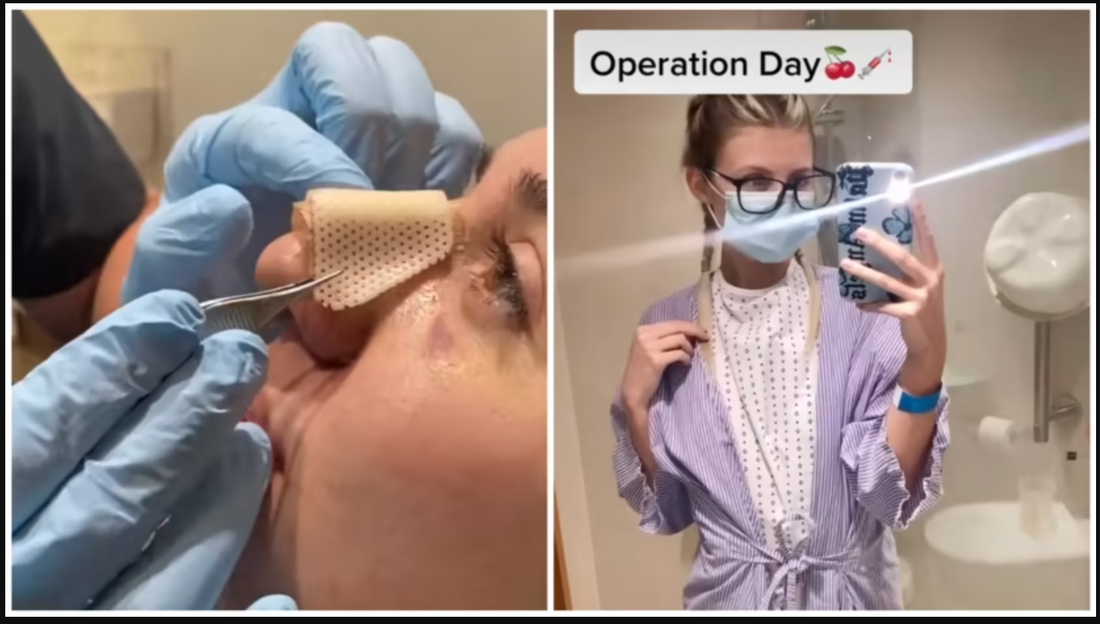"One out of three tiktok users is 14 or younger. What happens when that audience is constantly exposed to plastic surgery content?"--Vivien Mansbach, 9th grade
Plastic surgery is one of the biggest parts of the celebrity lifestyle, but can be so hushed-up that we are tricked into believing that everything we see in pictures is reality. Recently, many high-profile celebrities including Ariana Grande, Zac Efron and Kendall Jenner have come under scrutiny for denying the procedures they go through. This may seem relatively harmless but in effect promotes a (literally) impossible beauty standard, and, because these celebrities have such sway, can influence everyone else’s idea of what normal bodies look like.
Social media, often, is a place where many celebrities share intimate looks at their personal lives, but when none choose to reveal or make content relating to their physical alterations, other influencers invariably swoop in, specifically onTikTok. The extremely popular video sharing platform has skyrocketed in cosmetic surgery related content, including vlogs and before and after photos, but also a look at everything that can go wrong with getting plastic surgery. This increase in content can be positive, according to many influencers, because it ‘normalizes’ plastic surgery. This is a phrase that’s often been applied to physical things society tends to criticize - normalize asymmetrical faces, normalize cellulite, normalize arm fat- on TikTok and other social media platforms. It’s an innocently validating trend that can help individuals feel comfortable and celebrated in the parts of their bodies that are often hidden or criticized, but the same mindset can’t be properly applied to ‘normalizing’ plastic surgery, because it is not a normal or natural thing. It is becoming normalized through influential people’s denial of it - this can be extremely dangerous.
TikTok’s content surrounding plastic surgery can be a helpful reality check, shedding light on how expensive surgeries are, effectiveness rates, and the catastrophe which can ensue when procedures go wrong. However, it really begs the question of how we as a society have gotten here – to this place of getting all our information about permanent body modification surgeries from strangers on a social media platform, especially as a young person (TikTok is made up of one third viewers who are 14 or younger).
The most popular plastic surgery procedure on tiktok, rhinoplasty, a.k.a. a ‘nose job’, is marketed in particular towards young teens. Plastic surgeons, through hashtags and paid promotion, are able to show quick before and after videos of their procedures, the ‘after’ tearing up and disbelievingly caressing her newfound face. In this Insider article, staff members created an account as a fourteen year old girl and came across plastic surgery content after just eight minutes of scrolling. After turning on Restricted Mode, which Tiktok claimed would reduce exposure to this type of content, Insider repeated the experiment again “to see whether any plastic surgery videos would appear, and found a video promoting tummy tucks “after just six minutes of scrolling.”
Perhaps there is some truth in the statement that plastic surgery normalization on Tiktok offers an insight and transparency into these procedures and all that they cause. But it is also glorifying very expensive and dangerous, lifelong body modifications and promoting the beginning of an unhealthy and unmeetable beauty standard, especially for young people.
Social media, often, is a place where many celebrities share intimate looks at their personal lives, but when none choose to reveal or make content relating to their physical alterations, other influencers invariably swoop in, specifically onTikTok. The extremely popular video sharing platform has skyrocketed in cosmetic surgery related content, including vlogs and before and after photos, but also a look at everything that can go wrong with getting plastic surgery. This increase in content can be positive, according to many influencers, because it ‘normalizes’ plastic surgery. This is a phrase that’s often been applied to physical things society tends to criticize - normalize asymmetrical faces, normalize cellulite, normalize arm fat- on TikTok and other social media platforms. It’s an innocently validating trend that can help individuals feel comfortable and celebrated in the parts of their bodies that are often hidden or criticized, but the same mindset can’t be properly applied to ‘normalizing’ plastic surgery, because it is not a normal or natural thing. It is becoming normalized through influential people’s denial of it - this can be extremely dangerous.
TikTok’s content surrounding plastic surgery can be a helpful reality check, shedding light on how expensive surgeries are, effectiveness rates, and the catastrophe which can ensue when procedures go wrong. However, it really begs the question of how we as a society have gotten here – to this place of getting all our information about permanent body modification surgeries from strangers on a social media platform, especially as a young person (TikTok is made up of one third viewers who are 14 or younger).
The most popular plastic surgery procedure on tiktok, rhinoplasty, a.k.a. a ‘nose job’, is marketed in particular towards young teens. Plastic surgeons, through hashtags and paid promotion, are able to show quick before and after videos of their procedures, the ‘after’ tearing up and disbelievingly caressing her newfound face. In this Insider article, staff members created an account as a fourteen year old girl and came across plastic surgery content after just eight minutes of scrolling. After turning on Restricted Mode, which Tiktok claimed would reduce exposure to this type of content, Insider repeated the experiment again “to see whether any plastic surgery videos would appear, and found a video promoting tummy tucks “after just six minutes of scrolling.”
Perhaps there is some truth in the statement that plastic surgery normalization on Tiktok offers an insight and transparency into these procedures and all that they cause. But it is also glorifying very expensive and dangerous, lifelong body modifications and promoting the beginning of an unhealthy and unmeetable beauty standard, especially for young people.


